This post is by Guy Shrubsole. Updated 16th Dec 2017 with post-script on Birmingham’s secret tunnels.
The existence of a secret network of Cold War-era tunnels beneath central London can be confirmed by recently-released Land Registry data, Who Owns England can reveal.
There’s growing public interest in opening up previously hidden parts of subterranean London – from the unearthing of buried rivers, to the success of underground tourist ventures like the Cabinet War Rooms and the Mail Rail. But the authorities have remained reluctant to publicly confirm the existence of some of London’s most secretive tunnel systems – until now.
Last month, the Land Registry released free of charge its Corporate & Commercial dataset, which lists the 3.5 million land and property titles owned by all UK companies and corporate bodies. Some careful sifting of this vast dataset has uncovered various tunnels and underground chambers beneath London owned by the Post Office, BT, and the Ministry of Defence.
1. The Postmaster General’s secret tunnel beneath Whitehall
Browsing through the dataset, I stumbled across a very intriguing entry: a “Cable Chamber at the corner of Parliament Street and Bridge Street”, owned by ‘His Majesty’s Postmaster General’, who registered the freehold on 10th July 1951. Using the property title number, I decided to buy the title plan, to see precisely where this Chamber lies; it’s the small red square on the map below:

That puts it just outside the Parliament bookshop, near one of the exits to Westminster tube – here, on Google Street View:
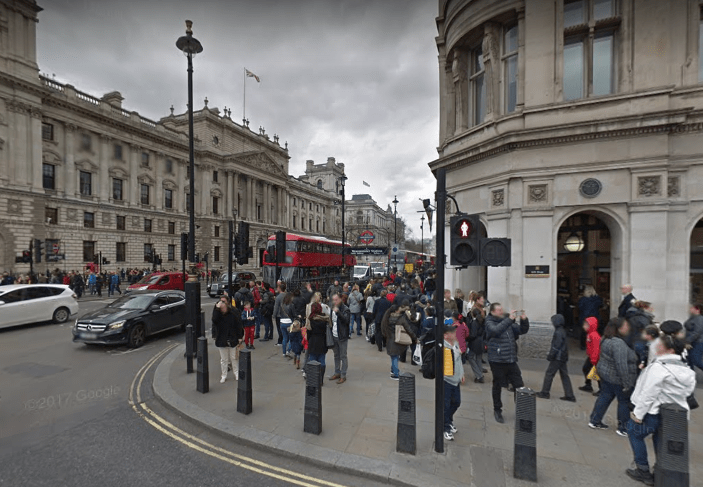
Why this small cable chamber is interesting is because it appears to corroborate other stories about Post Office tunnels beneath Whitehall, long the subject of legend on urban exploration internet forums.
In 1980, Duncan Campbell, a journalist at the New Statesman investigating the government’s preparedness for nuclear war, found an entrance to some of the Post Office’s tunnels and rode a bike along them, somehow evading security. “A manhole cover, gently raised, gives access to one of the Post Office’s thousands of subsurface cable chambers”, he wrote, before following the tunnels down towards Westminster, “a Post Office lair called Q-Whitehall.”
Campbell published the resulting photos in the Christmas edition of the NS, in a brilliant piece that both mocked and excoriated the Cold War security state. This, after all, was the era of Protect and Survive and When The Wind Blows, when the government was pretending that households could survive nuclear attack simply by painting their windows white, whilst building themselves ever-deeper concrete bunkers. He went on to publish maps of the tunnel network in his book War Plan UK; the one of Q-Whitehall is reproduced below:
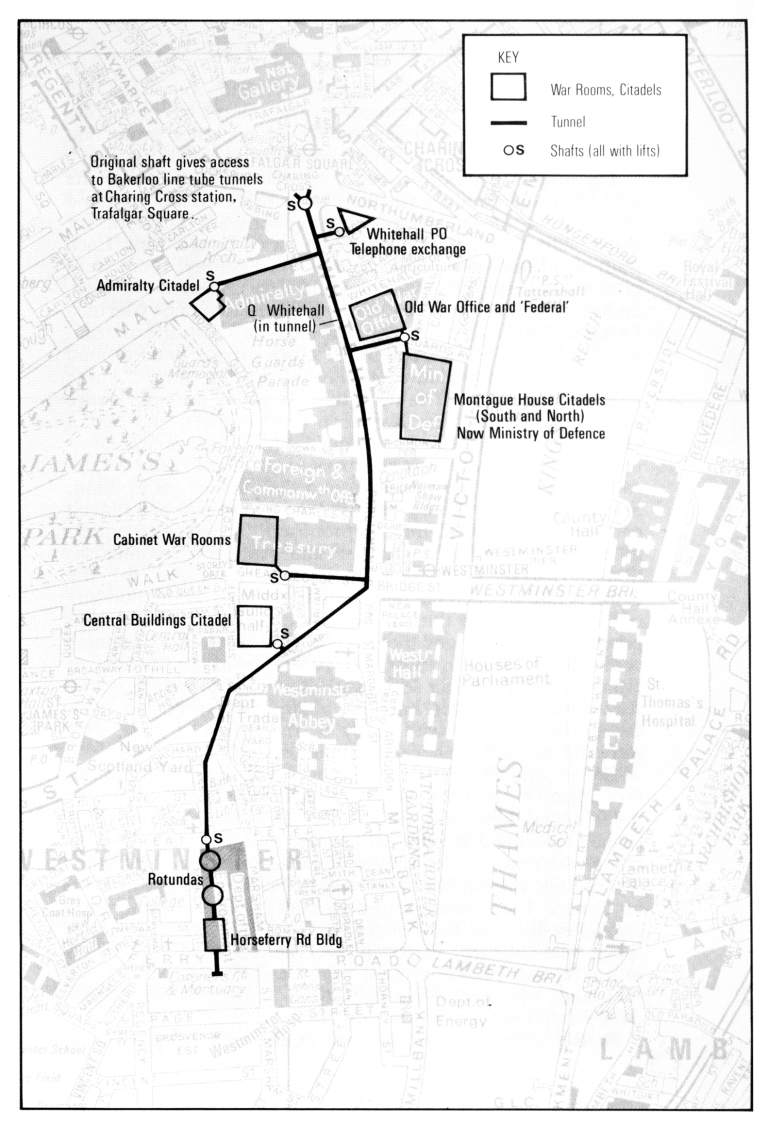
The Post Office tunnels were built in the 1940s, in the aftermath of World War II and with the prospect of atomic warfare looming. Aerial bombardment during the Blitz had forced the machinery of government underground, into the Cabinet War Rooms and elsewhere; now with the far greater threat of atomic strikes, it was decided that vital telecommunications channels should be buried deep beneath the surface so as to survive assault. One blogger has located an article about the construction of the Whitehall tunnels from a January 1946 Post Office engineers’ journal, published during the “short lived period where the government talked openly about what it had done during the war, before everything clamped down again as the Cold War started.”
Stephen Smith, a more recent chronicler of underground London, reckons that “no outsider has been into the tunnels since Campbell”. But at least with this new data from the Land Registry, we have official confirmation of their existence.
Campbell’s map of the Whitehall tunnel suggests that it has exit shafts under various government departments. So I decided to look through the Land Registry Corporate & Commercial dataset for any evidence of these. Sure enough, registered to ‘the Secretary of State for Defence’ (aka the MOD) is one “Vertical Shaft At Basement Level, Old War Office, Whitehall, London (SW1A 2EU)” – just as Campbell’s map shows. This raises fresh questions, however; since the Old War Office has been recently sold to the Hinduja Brothers, who are turning it into a hotel. Will access to the Whitehall tunnel remain closely guarded by the MOD, or will it become a tourist attraction for hotel guests?
2. The Atom Bomb-proof telephone exchange beneath High Holborn
Up until the 1980s, all telecoms was dealt with by the Post Office. Thatcher’s privatisation drive saw the hiving off of these functions and the creation of British Telecommunications Ltd (aka BT). Searching the Land Registry’s corporate dataset for BT’s land and property holdings throws up an even more intriguing set of secret underground tunnels, which it has inherited from its Cold War era predecessors.
In particular, this land title with a lengthy and mysterious description caught my eye: “That part of the subsoil which forms part of the underground works which became vested in Her Majesty’s Postmaster-General by virtue of the Post Office Works Act 1959 known as the London Works”. Interest duly piqued, I bought the title plan, and what it showed astonished me; a vast set of tunnels, shown in pink, stretching beneath High Holborn and Chancery Lane, deep beneath the level even of the Tube:
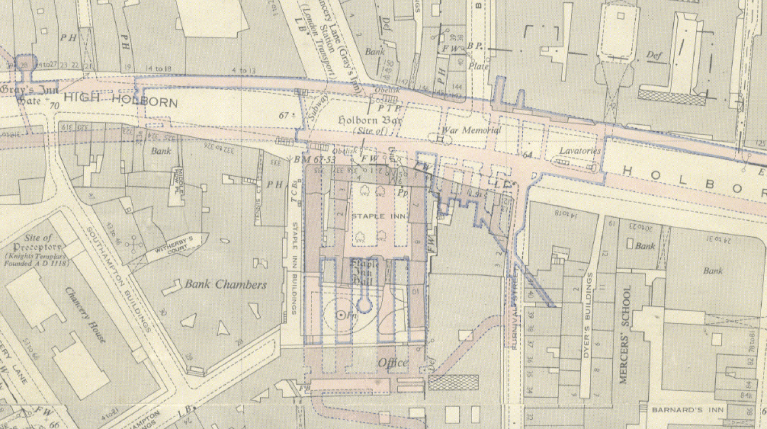
Digging further, I googled ‘Post Office Works Act 1959’, and turned up the transcript of a 15-minute debate held in the House of Lords on 20th January 1959. Lord Chesham, introducing the Bill for the government, assures his fellow Peers: “I do not think I need keep your Lordships very long in moving the Second Reading of this Bill… its purpose is to vest in my right honourable friend the Postmaster General certain deep-level chambers which were constructed under the Emergency Powers… Shortly after the war small underground shelters which had been constructed mainly in the borough of Holborn for the Ministry of Home Security were taken over by the Post Office. They were extended and they were adapted… All these works are now complete, and consist of underground rooms with connecting passages more than fifty feet below the surface of the ground. They are used for essential Post Office purposes”. Scant further details of the tunnel complex are supplied, but Lord Chesham had “arranged, for your Lordships convenience, for a copy of the book of reference and of the plans to be in the Library.”
In other words, the plans reproduced above were never made fully public at the time.
Authors Richard Trench and Ellis Hillman, in their book London Under London (1985), provide some more details of what became known as the Kingsway Exchange. “The Post Office pressed on with building its empire underground. Excavations began in 1951 for a vast underground telephone exchange at Kingsway. The backbone of the exchange was a twin tunnel 100 feet down on the northern side of High Holborn, between Hatton Garden and Red Lion Square, with Gray’s Inn Road running over it… Telecommunications plant, generators and repeating stations occupy most of the Hatton Garden side, while four extension tunnels, running beneath Chancery Lane Underground station, house switching units and an artesian well. A short cable tunnel links the exchange to the Post Office’s Holborn cable tunnel. The exchange, opened in October 1954, could handle two million calls a week”. (p.186)
After the end of the Cold War, Subterranea Britannica, a society of underground explorers, has been permitted to enter the Kingsway Exchange on two occasions. Their expeditions and photographs are online here. I took a walk around the area at ground level, and one sign of something odd going on below the surface is Number 39, Furnival Street, which looks to be one of the shafts where goods were sometimes transported in and out of the tunnels:
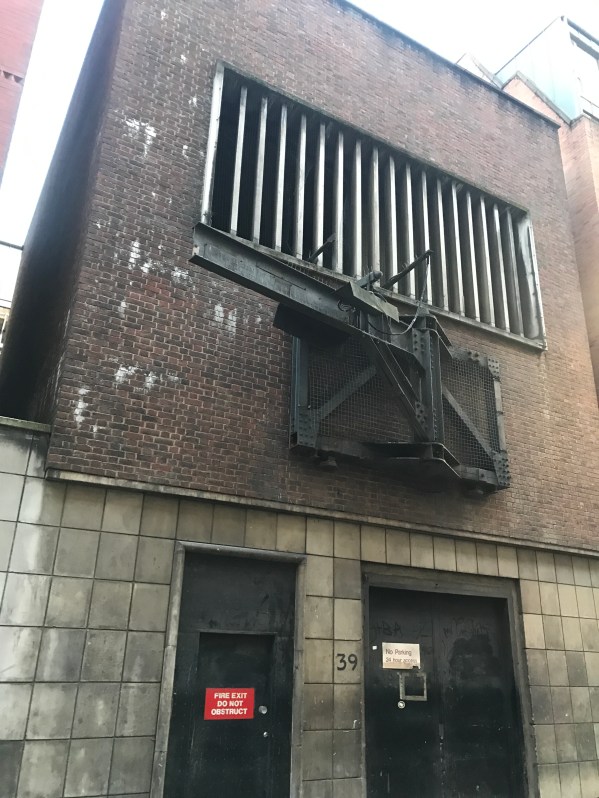
I’ve also discovered that the Kingsway Exchange appears in the Land Registry’s INSPIRE Index polygons for Camden, meaning that it’s easy to make a digital map of the tunnels (reproduced here for purposes of journalistic reporting):
The Land Registry records show that BT also owns a number of other tunnels and underground chambers:
- “Basement and Sub-Basement Cable Chambers, Cable Ducts, Tunnels and associated areas of Faraday Building North, Carter Lane, London”. A friend’s brother works for BT in their Faraday Building and has told me he’s seen evidence of these tunnels in the basement. Wikipedia notes that: “During the Second World War, the Faraday Building was transformed into a redoubt where the Cabinet could retreat if the need arose and the Prime Minister could run the war in greater security than Downing Street could provide.”
- “Cable chamber beneath Silver Street, London” and “the site of a cable chamber beneath part of the former site of Silver Street”. The title plan shows this to be near the Museum of London on London Wall.
- “Shafts and Tunnels at Moorgate Telephone Exchange, Fore Street, London (EC2Y 5BJ)” – again on London Wall, perhaps the same cable tunnel.
The Cold War is mercifully long over, and the paranoid secrecy of the state that accompanied it appears to have softened, at least in places. It’s a nice twist of history that some of the most secret Cold War sites are finally being revealed through the Land Registry’s embrace of more open data.
Post-script: Birmingham’s secret tunnels
After publishing this post, I was given a tip-off by @joolz_mc on Twitter that Birmingham, too, had similar secret tunnels under its city centre:
Similar to London I think. Evidence of ventilation shafts near the BT tower. I read when they were excavated workers were told they were for Birmingham’s underground. Can you access MapSearch on the Land Registry? I wonder if they are shown on there?
— joolz (@joolz_mc) December 16, 2017
So I took a look at the Land Registry’s INDEX Inspire polygons for central Birmingham, around the BT Tower (Brindley House and Telephone House) – and sure enough, there they were, a similar squiggly shape to the Holborn tunnels, buried beneath other more regular surface land parcels. (If you’re using QGIS to look for more tunnels like these, set the layer style to 50% transparency to reveal such ‘hidden’ polygons). Here’s a quick Google Map:
(It looks like one of the tunnels exits into a pub, The Queens Arms – might be worth asking the landlord if they have any really deep cellars…?!)
I bought the title plan for the Birmingham tunnel system [PDF], ownership of which was transferred to the Postmaster General in 1959, just like the Holborn network. Here’s a screengrab of the plan (North is on the right hand side):
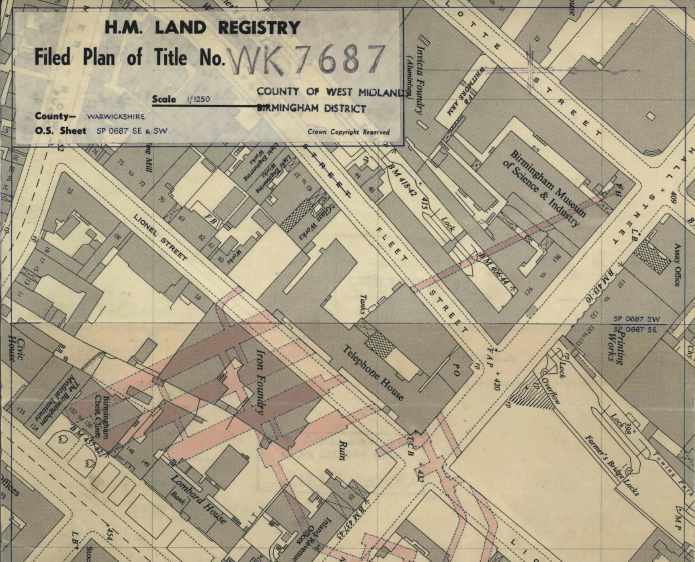
If you know of any other secret tunnels, whether beneath London, Birmingham or elsewhere, please post details in the comments thread below!

It’s fascinating to read about London’s secret tunnels but these should be properly secured as with the advent of terrorism in London I’m reminded of a certain Guido Fawkes!!
LikeLiked by 7 people
A few years ago (around 2005-2008?) I used to work just off Carter Lane and saw the demolition of the old Faraday Building North — lots of concrete that took a long time to remove. The last bit to remain was the top of a staircase on the corner of Carter Lane and Addle Hill, facing what’s now a youth hostel. One evening as I walked past four or five men in hard hats emerged through the doors into the street — clearly they’d been on a tour of inspection.
Not long after that the rest of the building was removed and the Grange St Paul’s hotel was built over the entire site.
Addle Hill still has a steel door marked ‘fire exit’ in the side of the hotel in Addle Hill. I imagine this is the new access to the underground works.
There’s also a picture of the wartime works in Carter Lane (the top of a shaft) in Andrew Emmerson’s book, London’s Secret Tubes.
LikeLiked by 6 people
Hi,
There’s a lot more going on underneath Birmingham – have a look at Anchor and Angel bunkers (vent shaft for one is behind WMP HQ). There’s an urban legend that the ring road in Brum was built as cover for bunker construction and I could believe it as there are lots of access doors in some of the ring road tunnels
LikeLiked by 5 people
Looking at the C&C dataset there is one more of these Postmaster-General tunnel complexes – in Manchester, underneath Chinatown. Hidden Manchester has a map which shows the tunnels stretching even further than the land registry suggests.
LikeLiked by 4 people
Fascinating… wasn’t aware of the gov.uk dataset you mentioned here. I took a look for Manchester and sure enough the Guardian Underground Telephone Exchange in Manchester was modelled. Took a while to extract and convert to GeoJSON but on comparison with the trace I made from a plan in Cold War: Building for Nuclear Confrontation it’s actually less detailed! You can see the version I’ve reproduced here: http://hidden-manchester.org.uk/gute/guardian-underground-telephone-exchange.html
LikeLiked by 9 people
impressive work!
LikeLike
Wikipedia has an article on Birmingham’s “secret” tunnels, the Anchor Exchange”:
https://en.wikipedia.org/wiki/Anchor_telephone_exchange
LikeLiked by 4 people
…and on the “Kingsway Exchange”, in London:
https://en.wikipedia.org/wiki/Kingsway_Exchange
and Manchester’s “Guardian Exchange”:
https://en.wikipedia.org/wiki/Guardian_Exchange
There is also mention of a rumoured fourth exchange, in Glasgow.
LikeLiked by 3 people
In the early eighties I worked in Holborn. There was a public convenience in the middle of the road that closed for “repairs”. The huge number of workmen going down each day fed the rumours that there was a lot more going on.
LikeLiked by 5 people
Ben Waddington (@falsedog) has done a lot of work on Birmingham’s tunnels:
http://www.birminghampost.co.uk/business/creative/hidden-spaces-subterranean-birmingham-exploring-9345738
LikeLiked by 5 people
What about the one supposedly under Oxford Street?
LikeLiked by 4 people
Not quite secret tunnels, but Nottingham has caves all over the place; some of them are open to the public (there’s a museum) but others aren’t publicly known about because they come out into people’s gardens and things. My Father, who is a builder, used to be forever seeing them in basements in both commercial and residential properties. Recently some people have been mapping them, they have a website here: http://tparchaeology.co.uk/caves/caveswebsite/
LikeLiked by 5 people
A while back BT tried to sell the tunnels under Holborn and the Telegraph published some great photos, as I understand it though the sale fell through because of health and safety restrictions limiting any future re-purposing of the tunnels.
http://www.telegraph.co.uk/finance/newsbysector/mediatechnologyandtelecoms/3328838/BT-tunnels-under-central-London-up-for-sale.html
http://www.telegraph.co.uk/finance/4324339/Kingsway-Tunnels-See-inside-one-of-Londons-most-unusual-property.html
LikeLiked by 6 people
Below Corsham in Wiltshire is a vast array of underground rooms which were to be used as a government centre is the event of nuclear war. (Size 240 acres – about 180 football fields)
LikeLiked by 3 people
Heard rumours of a tunnel leading from Buckingham palace to Admiralty Arch at the opposite end of Pall Mall. Perhaps an evacuation route for the queen in the wake of an attack? Admiralty arch is currently abandoned/disused although it has round the clock security inside and out, and remains on the small list of buildings that come under criminal trespass law. Something doesn’t add up there….
LikeLiked by 6 people
I heard this too when I used to work for a sightseeing company
LikeLiked by 1 person
True, its also connected to the cable tunnels and you can come up at a number of different places across London.
LikeLiked by 1 person
hi having come across the webpage just now i would like to say having worked in admiralty arch for 4 years (1990s)i never came across any tunnel going up the mall to buck house,there is a tunnel which goes across one side of the mall to the other under the road with various small off shoot corridors with one door in same door out which were being used as rubbish/storerooms nothing else.
LikeLiked by 1 person
A very interesting read! However, it must be noted that not all tunnels are or ever will be put on the Land Registry, nor is all the information relative to them on their either. For example, there are locations on the London Underground network where LU are contractually not able to disclose the presence and ownership perspectives of their infrastructure or in some cases leased infrastructure within the land of other parties. In addition, tunnel crown depths and widths may also not be accurately recorded. There was a paper produced some time ago by a solicitor discussing under ground land registration which is quite informative. So we do need to be careful about how we interpret such data. All very interesting though despite this!!
LikeLiked by 4 people
For an accurate plan of the Whitehall Tunnels see p134 in Nick Catford’s ‘Secret Underground London’
LikeLiked by 4 people
Fascinating.. Anyone with info on the tunnels under Chester?
LikeLiked by 3 people
Please post a link to the full London Title Plan, as you have done for Birmingham’s.
LikeLiked by 3 people
Guy – did you see this request?
LikeLiked by 1 person
Apologies – missed it – will add the full title plan shortly!
LikeLike
Now added in link (‘bought the title plan’ in section 2 above)
LikeLiked by 1 person
Thank you
Where is the other route to get in a part from Furnival Street?
I had a look around, is there one still in 31-33 Chancery Buildings on High Holborn Street?
Or a secret route through the old tube station?
LikeLike
Brilliant! Thank you. Now used on Wikipedia:
https://en.wikipedia.org/wiki/Kingsway_telephone_exchange
as is the Birmingham map:
https://en.wikipedia.org/wiki/Kingsway_telephone_exchange
LikeLike
Brilliant! Thank you. Now used on Wikipedia:
https://en.wikipedia.org/wiki/Kingsway_telephone_exchange
as is the Birmingham map:
https://en.wikipedia.org/wiki/Anchor_telephone_exchange
LikeLiked by 1 person
You should have a look into the old war uses of the Wormwood scrubs common, in west London (w10) apparently was used also used as a pow camp
LikeLiked by 4 people
And the old Wood Lane underground station adjacent to White City station opposite the BBC
LikeLiked by 1 person
See also Peter Laurie ‘Beneath the city streets’ – 1st edition Penguin 1970 2nd edition Granada Panther 1979 ISBN 0586 05055 8 e.g. Amazon https://www.amazon.co.uk/Beneath-City-Streets-Peter-Laurie/dp/0586050558/ref=sr_1_5?s=books&ie=UTF8&qid=1513762558&sr=1-5&keywords=beneath+the+city+streets
LikeLiked by 3 people
Brilliant article – really enjoyed reading this – Many Thanks – Ian
LikeLiked by 2 people
Superb article – many thanks – Ian
LikeLiked by 2 people
Reblogged this on clawingmywayin and commented:
interesting
LikeLiked by 2 people
Underground tunnels. If I ever make it back to the UK and I go to London, I hope there are tours for some of these tunnels.
LikeLiked by 1 person
Woah, this is a very interesting post! Secret tunnels always amaze me regardless of where they are!
LikeLiked by 2 people
Interesting read!
LikeLiked by 2 people
Reblogged this on Lincoln Life Blog.
LikeLiked by 2 people
Nice research
LikeLiked by 1 person
Absolutely fascinating, and well done. It’s an incredibly unique slice of history. Thank you for sharing- those maps really bring it all together!
LikeLiked by 2 people
re Glasgow
Talk of Glasgow interests me. The old Telephone Exchange ( https://canmore.org.uk/site/164582 ) is on Pitt street which conveniently is/was the same street as the Old Police Headquarters ( which is about to be bulldozed, but a college before 1964 ) and the MOD building south of Argyle st ( Kentigern House ) There is a post online saying ” Kentigern House has a bunker in the basement and the whole building has positive pressure air system to keep out nasties. In addition to this there is a small albeit functional range within the building and a tunnel connecting it to another building which was not mentioned” ( http://www.hiddenglasgow.com/forums/viewtopic.php?f=15&t=7&start=345#p161253 )
Before Anderston was wiped away Pitt Street extended to McAlpine Street which is the west side of Kentigern House ( http://maps.nls.uk/view/82891758#zoom=4&lat=6150&lon=11262&layers=BT ) [ pre war map to show streets but nor buildings mentioned.]
Of all things Glasgowlive had an article talking about the tunnels very recently; http://www.glasgowlive.co.uk/news/history/take-a-look-inside-glasgows-12828668
I know there are extensive maps of the mine works and tunnels of Glasgow around and they should show any working tunnel or excluded areas.
LikeLiked by 3 people
Thanks. Very interesting. I’ve always suspected that there is a tunnel that is big enough to walk along in Southampton near to the courts that is owned by BT. I might do some investigating of my own…
LikeLiked by 2 people
Very interesting, and thanks for sharing. I would love to travel to England some time and explore. I’m in the states. It reminds me of the underground NYC tunnels in the book I just got published.
LikeLiked by 2 people
I do believe many/most cities have this also.
LikeLiked by 2 people
When I was a teenager, some forty five years ago, my uncle Ellis Hillman, co-author of London Under London, took me down into some of the London tunnels that were used as shelters during WWII. There were still government war posters on the walls, as I recall.
LikeLiked by 3 people
Hi, I’m really interested in this, does the book have any information as to how to access these tunnels? Is the government aware of these tunnels and if so, are they still open to the public somewhat? Thank you for your time!
LikeLike
This was a fascinating read!
LikeLiked by 1 person
Amazing
LikeLiked by 2 people
Nice one
LikeLiked by 3 people
Reblogged this on akbarramshah.
LikeLiked by 3 people
Loved reading this! Fascinating read 🙂
LikeLiked by 2 people
Very interesting read 👍🏻
LikeLiked by 1 person
I was lucky enough to be the chosen engineer to work in the tunnels for BT doing the lighting. I walked the entire system and it was the most fascinating thing I’ve done. I was in there for 4 months and always had to have a chaperone, not just for security but I would have got lost. All the tunnels are marked with letters and there’s no maps. No food or cardboard allowed so the rats can’t live there. In 4 months I never sore a rat. Also, it smells exactly the same as the Undergraound, went through all sizes or tunnels from cable runs which where 1 metre wide and had to bend to walk through right up to 10 metre wide tunnels with more cables in than I will ever see again, huge amount. Also you had to watch out for the cable stands. Inch thick iron which stuck right out creating a narrow gap through the middle and if you whacked your arm on them you knew about it. Finally an example of how much tunnelling there is, I bought a brand new set of boots at the start and by the end they were immaculate except they had no sole left at all, totally worn away with all the walking. Best job I’ve even done and would love to go back down again.
LikeLiked by 2 people
Fantastic work.
LikeLike
I believe Cardiff also has a similar system of underground tunnels owned by BT – apparently they needed large tunnels to accommodate the communication needs of the growing city, but I’m pretty sure they didn’t need to be big enough to drive two transit vans side by side! Also, Cardiff has an underground canal system from years past – still partially visible from Greyfryers rd area
LikeLiked by 1 person
Great article. I love to read about things like this, they make great fiction story ideas. I appreciate the many maps included as well.
LikeLike
Thanks great read
What’s the land registry title number for the kingsway tunnels
I can see the information for the Birmingham tunnels, just not the kingsway one
Very interesting thank you
LikeLike
Thanks! No probs, it’s title number LN182998.
LikeLike
Thank you so much
Do you know the easiest and safest way of entering the tunnel?
I want to gain entry
Cheers
LikeLiked by 1 person
That I am afraid I cannot help you with, but you may wish to have a look at this blog: http://www.guerrillaexploring.com/gesite/public_html/index.php?option=com_content&view=article&id=355:ges227-kingsway-exchange&catid=5:subterranean&Itemid=10&jjj=1521228851149
LikeLiked by 1 person